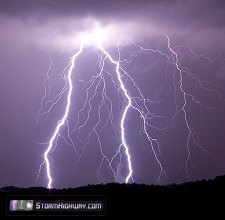Lightning Types and Classifications
|
In September of 2025, my work is generating the most income it ever has in my career. Yet, I'm being forced to shut down my successul operation, against my will, due to one cause alone: 95% of that revenue is being stolen by piracy and copyright infringement. I've lost more than $1 million to copyright infringement in the last 15 years, and it's finally brought an end to my professional storm chasing operation. Do not be misled by the lies of infringers, anti-copyright activists and organized piracy cartels. This page is a detailed, evidenced account of my battle I had to undertake to just barely stay in business, and eventually could not overcome. It's a problem faced by all of my colleagues and most other creators in the field. |
On a small scale, all lightning is essentially the same - a channel of ionized air carrying electrical current between two differing areas of charge. The polarity of a lightning leader can affect the way it propagates and branches in space and time, but in the end, it's all an electrostatic discharge - a 'spark' in its fundamental sense. The little 'static' sparks between your finger and a doorknob are, technically speaking, the same basic process at work, just on a smaller scale. The 'types' of lightning we'll discuss here refer more to how a lightning event appears to an observer and the polarity of these visible sections.

Negative Cloud-to-Ground Lightning |
Cloud-to-Ground Lightning - Negative
A lightning flash between cloud and ground where the negative end of an in-cloud bidirectional leader descends to the ground via a downward-moving, negatively-charged stepped leader. Abbreviated "-CG". Negative CGs are more common than positive CGs. Most of the lightning you can see striking the ground in a storm is of the negative cloud-to-ground variety. Negative cloud-to-ground lightning strikes can be identified visually and in photographs by their distinctive downward branching (aside from the portion of the channel very close to the ground, where upward leaders can be branched upward).
Negative CGs commonly consist of multiple "return strokes", which are additional pulses of current that illuminate the channel again and again. The first return stroke of a negative CG is usually the only branched one - the branches usually do not illuminate again in subsequent return strokes.
ARTICLE: In-depth look at cloud-to-ground lightning
PHOTOS: Cloud-to-Ground Lightning Gallery |
|

Positive Cloud-to-Ground Lightning |
Cloud-to-Ground Lightning - Positive
A lightning flash between cloud and ground where the positive end of an in-cloud bidirectional leader descends to the ground via a positively-charged leader. Abbreviated "+CG". Positive CGs are less common than negative CGs, and usually are associated with supercell thunderstorms and trailing stratiform precipitation regions behind squall lines. Most positive cloud-to-ground lightning strikes can be identified visually and in photographs by their distinctive lack of branching, especially close to the ground (positive CGs occasionally will have branching at higher altitudes, but rarely near the ground).
Positive CGs usually consist of only one return stroke, which is typically very bright and intense relative to other lightning activity in a storm. It is common for photographs of positive CGs to be overexposed unless the photographer has stopped the lens down significantly. Thunder from a positive CG is typically very loud, and many times sounds like a series of deep, low-frequency sonic booms.
Sprites (see below) are usually associated with the more intense positive CGs.
ARTICLE: In-depth look at cloud-to-ground lightning
PHOTOS: Cloud-to-Ground Lightning Gallery |
|

Ground-to-Cloud Lightning |
Ground-to-Cloud Lightning
Ground-to-Cloud lightning (sometimes called Upward-moving lightning) is a flash between cloud and ground initiated by an upward-moving leader originating from an object on the ground. Ground-to-Cloud lightning strikes are common on tall towers and skyscrapers. GC lightning can also be either positive or negative in polarity, but the vast majority are positive. Lightning that demonstrates upward branching is a clear indication of a ground-to-cloud flash, though some upward-moving lightning is branchless below cloud base.
ARTICLE: Article: In-depth look at ground-to-cloud lightning
PHOTOS: Ground-to-Cloud (Upward) Lightning Gallery
|
|

Intracloud Lightning |
Intracloud Lightning
The most common type of flash - lightning inside a single storm cloud where both ends of the bidirectional leader stay entirely in the storm cloud. Intracloud lightning is sometimes called sheet lightning because it lights up the sky with a 'sheet' of light. All or parts of the actual channel may be obscured inside the cloud, and may or may not be visible to a chaser on the ground. Not to be confused with cloud-to-cloud lightning.
PHOTOS: Intracloud/Anvil Crawler Lightning Gallery
|
|

Anvil Crawler |
Anvil Crawlers
 Anvil Crawlers are horizontal, tree-like, in-cloud lightning flashes whos leader propagation is resolvable to the human eye. In other words, the anvil crawler's movement is slow enough (compared to most lightning flashes) that a human observer or normal-speed video camera can see its rapid motion across the sky. This type of lightning (sometimes referred to as 'crawlers' or 'rocket lightning') often cover very large distances, resulting in vast, spectacular sky-filling flashes. Anvil Crawlers are horizontal, tree-like, in-cloud lightning flashes whos leader propagation is resolvable to the human eye. In other words, the anvil crawler's movement is slow enough (compared to most lightning flashes) that a human observer or normal-speed video camera can see its rapid motion across the sky. This type of lightning (sometimes referred to as 'crawlers' or 'rocket lightning') often cover very large distances, resulting in vast, spectacular sky-filling flashes.
Anvil crawlers are often very high-altitude events, and as such typically result in soft, rolling thunder due to their great distance from the observer. The name 'anvil crawler' is derived from the visible 'crawling' motion and their tendency to appear along the underside of the anvil portions of a thunderstorm. Anvil crawlers can either occur independently completely within the cloud, or in connection with a cloud-to-ground flash. Click the images below to enlarge
 
PHOTOS: Intracloud/Anvil Crawler Lightning Gallery |
|

Bolt from the Blue |
Bolt from the Blue
A bolt from the blue (sometimes called 'anvil lightning' or 'anvil-to-ground' lightning) is a name given to a cloud-to-ground lightning flash that strikes far away from its parent thunderstorm. A 'bolt from the blue' happens when one end of a growing bidirectional leader (usually the negative end) propagates outside of the cloud, far away from it, then turns toward the ground. Due to the final ground strike point being a significant distance from the storm (sometimes up to ten miles away), these lightning events can occur at locations with clear 'blue' skies overhead - hence the name.
Contrary to myth, most 'bolts from the blue' are negatively-charged, but positively-charged ones do occur on rare occasion.
PHOTO: View larger image |
|

Cloud-to-Air Lightning |
Cloud-to-Air Lightning
Referring to a flash (or a portion of a flash) jumping from a cloud into clear air. Technically speaking, all cloud-to-ground lightning strikes contain 'cloud-to-air' components in the many branches that extend away from the main channel and terminate abruptly in mid-air. However, the most visually dramatic examples of cloud-to-air lightning occur when a long, bright lightning channel jumps out of the side of a cumulonimbus cloud and terminates in the clear air surrounding the storm. Such events are actually failed "bolts from the blue" where the flash event terminates early before the leader can reach the ground.
PHOTO: View larger image
|
|

Cloud-to-Cloud Lightning |
Cloud-to-Cloud Lightning
A rare type of flash between two or more completely separate storm clouds. Not to be confused with common intracloud lightning occuring within one storm cloud.
PHOTO: View larger image
|
|

Bead Lightning |
Bead Lightning
Bead Lightning is a name given to the decaying stage of a lightning channel in which the luminosity of the channel breaks up into segments. Nearly every lightning flash will exhibit 'beading' as the channel cools immediately after a return stroke, sometimes referred to as the lightning's 'bead-out' stage. 'Bead lightning' is more properly a stage of a normal lightning flash rather than a type of lightning in itself.
Beading of a lightning channel is usually a small-scale feature, and therefore is often only apparent when the observer/camera is close to the lightning.
PHOTOS: Bead Lightning Gallery
|
|

Ribbon Lightning |
Ribbon Lightning
Ribbon Lightning refers to the visual appearance of a photographed lightning flash's individual return strokes being separated by visible gaps on the final exposure. This is typically caused by wind blowing the lightning channel sideways during the exposure. The stronger the wind and closer the lightning strike, the more horizontal displacement will exist on the recorded image.
Camera movement during the capture of a lightning photograph can also result in the same effect:

PHOTO 1: Wind-blown lightning channel: View larger image
PHOTO 2: Lightning captured with moving camera: View larger image |
|

Sheet Lightning |
Sheet Lightning
Sheet Lightning is a term used to describe clouds illuminated by a lightning flash where the actual lightning channel is either inside the clouds or below the horizon (not visible to the observer). Sheet lightning is, simply speaking, ordinary lightning (cloud-to-ground, intracloud, etc) that is hidden by clouds or terrain aside from the flash of light it produces. |
|
Sprites and Jets
Electrical flashes that occur high above active thunderstorms. Sprites appear as vertical red columns. They have been found to occur in conjunction with and/or as a reaction to positive cloud-to-ground lightning flashes. They are swift and faintly lit, making them nearly invisible to the naked eye and difficult to photograph. These phenomena are best viewed at long distances from large thunderstorm complexes, at least 100 miles away.
PHOTO: View larger image |
|
Other lightning types
This animation depicts several types of lightning. Can you identify them?
|
 About the Author: Dan Robinson has been a storm chaser, photographer and cameraman for 34 years. His career has involved traveling around the country covering the most extreme weather on the planet including tornadoes, hurricanes, lightning, floods and winter storms. Dan has been extensively published in newspapers, magazines, web articles and more, and has both supplied footage for and appeared in numerous television productions and newscasts. He has also been involved in the research community, providing material for published scientific journal papers on tornadoes and lightning. |
GO: Home | Storm Chase Logs | Photography | Extreme Weather Library | Stock Footage | Blog
Featured Weather Library Article:
|